
California Fish and Wildlife Journal
Scope & Guideline
Empowering Research for Sustainable Wildlife Management
Introduction
Aims and Scopes
- Wildlife Conservation and Management:
The journal focuses on the conservation of various species, including both terrestrial and aquatic wildlife, emphasizing strategies for management, recovery, and habitat restoration. - Ecological Research:
Research published often includes ecological assessments and studies on species interactions, habitat suitability, and population dynamics, contributing to a better understanding of ecosystem functions. - Human-Wildlife Interactions:
Many articles explore the impacts of human activities on wildlife, including fishing practices, land use changes, and conservation policies, highlighting the need for sustainable management practices. - Genetic and Molecular Studies:
The journal features advancements in genetic techniques for wildlife studies, including population genetics and noninvasive sampling methods, which enhance the understanding of species health and diversity. - Climate Change Impacts:
There is a growing emphasis on researching the effects of climate change on wildlife populations and habitats, addressing vulnerabilities and adaptive strategies in a changing environment.
Trending and Emerging
- Conservation Genetics and Noninvasive Techniques:
There is a notable increase in studies utilizing genetic methods and noninvasive sampling for monitoring wildlife populations, indicating a trend towards more precise and less intrusive research methodologies. - Impact of Climate Change on Wildlife:
Recent articles increasingly address the implications of climate change on various species and ecosystems, demonstrating a growing recognition of climate-related challenges in wildlife management. - Habitat Restoration and Suitability Modeling:
A trend towards developing habitat suitability models and restoration strategies shows the journal's commitment to addressing habitat degradation and ensuring the viability of wildlife populations. - Human Dimensions of Wildlife Management:
Emerging themes include the social and behavioral aspects of wildlife management, such as human-wildlife conflict and community engagement in conservation efforts, reflecting an interdisciplinary approach to wildlife issues. - Microplastics and Environmental Pollutants:
Research on the impacts of microplastics and other environmental pollutants on wildlife health is gaining traction, emphasizing the need for addressing pollution as a critical conservation issue.
Declining or Waning
- Traditional Fishery Management Techniques:
There appears to be a reduced focus on conventional fishery management practices, likely due to the rise of more innovative and integrated approaches that consider broader ecological interactions. - In-depth Historical Studies:
Research with a strong historical focus, such as studies on past wildlife management practices or historical population dynamics, seems to be diminishing, possibly overshadowed by contemporary ecological challenges. - Generalized Habitat Assessments:
There is less emphasis on generalized habitat assessments without specific species focus, as recent publications trend towards targeted studies that provide actionable insights for particular species or ecosystems. - Species-Specific Case Studies:
The journal is moving away from case studies that focus solely on individual species without broader ecological implications, indicating a shift towards more integrative conservation strategies.
Similar Journals
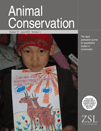
ANIMAL CONSERVATION
Uniting Voices for Global Conservation Efforts.Animal Conservation is a prestigious journal that serves as a vital platform for the dissemination of research dedicated to the preservation of wildlife and habitats. Published by Wiley, this journal has established a significant presence in the fields of Ecology and Nature and Landscape Conservation, holding a distinguished Q1 category ranking for both in 2023. With an impressive Scopus rank of #25 in the realm of environmental science, it caters to a global audience keen on understanding and addressing pressing conservation issues. The journal provides researchers, professionals, and students with high-quality, peer-reviewed articles that explore innovative methods and strategies in animal conservation. With its continuous publication since 1998, encompassing a comprehensive range of topics, Animal Conservation is indispensable for anyone aiming to make impactful contributions to the field of ecology and conservation biology.
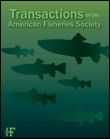
TRANSACTIONS OF THE AMERICAN FISHERIES SOCIETY
Illuminating the path for fisheries innovation and sustainability.TRANSACTIONS OF THE AMERICAN FISHERIES SOCIETY, published by Wiley, is a leading journal dedicated to the field of fisheries science and aquatic ecology, with a rich history dating back to its inception in 1872. As an esteemed publication within the realms of Aquatic Science and Ecology, Evolution, Behavior, and Systematics, it currently holds a Q2 quartile ranking, demonstrating its significance and influence in these disciplines. The journal is not open access, which enables a curated peer-review process while ensuring high-quality research dissemination. The journal serves as a vital platform for scholars and practitioners alike, providing essential insights into the management and conservation of aquatic resources. Its commitment to addressing contemporary challenges faced in fisheries and aquatic environments makes it indispensable for researchers, professionals, and students seeking to contribute to this dynamic field.

Revista Agrogeoambiental
Fostering Knowledge Exchange in Agricultural SciencesRevista Agrogeoambiental is a prestigious open-access academic journal dedicated to the field of agricultural and environmental sciences. Published by INST FEDERAL SUL MINAS GERAIS-I FSULDEMINAS since 2009, this journal stands as a vital forum for the dissemination of research findings, innovative methodologies, and interdisciplinary studies that address critical issues in agriculture and environmental sustainability. With a focus on promoting knowledge exchange among researchers, practitioners, and educators, Revista Agrogeoambiental seeks to enhance understanding of agroecological systems and their interaction with geospatial frameworks. As an open-access journal, it ensures that cutting-edge research is accessible to a wide audience, thereby fostering collaboration and knowledge-sharing in the global academic community. Researchers and professionals can benefit from the journal's commitment to high standards of scholarship, as well as its role in shaping policy and practice within the agricultural and environmental sectors.

JOURNAL OF WILDLIFE MANAGEMENT
Innovating solutions for ecological challenges in wildlife management.Welcome to the Journal of Wildlife Management, a premier publication dedicated to advancing the science and practice of wildlife management. Published by Wiley, this journal spans decades of impactful research and has been a cornerstone in the fields of Ecology, Evolution, Behavior, and Nature and Landscape Conservation. With an impressive ranking in the Q1 quartile across multiple disciplines, it provides a crucial platform for interdisciplinary collaboration and dissemination of knowledge among researchers, practitioners, and policy-makers. Covering a wide range of topics pertinent to wildlife management, this journal promotes innovative techniques and sustainable practices that are essential in addressing contemporary ecological challenges. The Journal of Wildlife Management is rigorously peer-reviewed, ensuring high standards of quality and relevance, making it an invaluable resource for those committed to conservation and ecological research.

Global Ecology and Conservation
Pioneering research in the heart of conservation efforts.Global Ecology and Conservation, published by Elsevier, stands as a premier open-access journal dedicated to advancing the field of ecology and conservation science. Since its inception in 2014, the journal has facilitated the dissemination of high-quality research, fostering critical dialogue on ecosystem management, biodiversity preservation, and sustainability practices across the globe. With a remarkable ranking within the top quartiles (Q1) in various categories including Ecology, Evolution, Behavior and Systematics, and Nature and Landscape Conservation, it is positioned among the leading resources for researchers and professionals alike. The journal has garnered a notable impact, ranking #65 out of 721 in Ecology, and houses articles that are vital to understanding and addressing the pressing environmental challenges of our time. Available in an open-access format, researchers can freely access and share vital findings, promoting a collaborative approach to ecological research. Global Ecology and Conservation is not just a publication; it is a critical tool for innovation and advocacy in conservation, poised to inspire the next generation of environmental stewards.
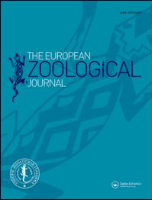
European Zoological Journal
Elevating the Study of Animal Sciences Across EuropeEuropean Zoological Journal, published by Taylor & Francis Ltd, is an esteemed open-access publication dedicated to advancing the exciting field of zoology. Since its inception in 2017, this journal has progressively established itself as a vital resource for researchers, professionals, and students alike. With its Q2 ranking in Animal Science and Zoology as of 2023, the journal ranks in the 69th percentile among its peers, showcasing its influence and contribution to the discipline. The journal’s broad scope covers a wide range of topics within zoology, aiming to foster an understanding of animal biology and conservation efforts. As an open-access journal, it not only enhances the dissemination of knowledge but also encourages collaborative research across global communities. Situated in the United Kingdom, the European Zoological Journal invites submissions that contribute to the evolving discourse in animal sciences, and endeavors to support the scientific community in addressing pressing ecological challenges.
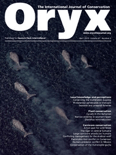
ORYX
Pioneering Research for a Sustainable FutureORYX, published by Cambridge University Press, stands as a prestigious scholarly journal in the fields of Ecology, Evolution, and Conservation. With an ISSN of 0030-6053 and E-ISSN 1365-3008, this journal has been a critical platform for researchers and professionals since its inception in 1950. Recognized for its excellence, ORYX ranks in the Q1 quartile for both Ecology, Evolution, Behavior and Systematics and Nature and Landscape Conservation as of 2023, highlighting its influential contributions to the field. With a strong focus on disseminating innovative research and fostering collaboration among scientists, the journal covers a broad array of topics, from biodiversity and ecosystem services to conservation strategies and policy implications. As a result, ORYX provides invaluable insights that help shape the future of environmental science. Its impressive Scopus rankings place it in the top 80th percentile in its categories, further underscoring its importance and appeal among academics, professionals, and students alike.

EUROPEAN JOURNAL OF WILDLIFE RESEARCH
Bridging knowledge gaps in wildlife ecology and management.European Journal of Wildlife Research, published by SPRINGER, is a key academic resource in the fields of ecology, evolution, behavior, and systematics, as well as management, monitoring, policy, and law related to wildlife conservation. With an impressive Q2 categorization among its peers, this journal serves as a vital platform for interdisciplinary research, fostering dialogue among researchers, conservationists, and policymakers. The journal focuses on innovative studies that delve into wildlife ecology, population dynamics, and species management, contributing significantly to our understanding and preservation of biodiversity in various landscapes. Although its coverage in Scopus ended in 2003, the journal's heritage is deeply rooted in the field, dating back to its inception in 1955, and continues to influence contemporary research practices. As an open-access journal, it allows for broad dissemination of knowledge, ensuring that vital findings reach a global audience, making it a valuable reference for students, professionals, and academics committed to wildlife research.
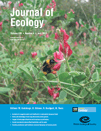
JOURNAL OF ECOLOGY
Shaping the future of ecological research and discourse.JOURNAL OF ECOLOGY, published by Wiley, stands as a leading publication in the field of ecology, evolution, behavior, and plant science, currently positioned in the prestigious Q1 quartile across these categories. Established in 1976, the journal has consistently provided a platform for innovative research and critical discourse related to ecological patterns, processes, and interactions. With its robust Scopus ranking—31st out of 721 in Ecology, Evolution, Behavior and Systematics, and 26th out of 516 in Plant Science—this journal notably reflects the high impact and influence of its articles in the scientific community. Although it does not offer open access options, the journal ensures comprehensive dissemination of pivotal findings to researchers, professionals, and students alike. Located in the United Kingdom at 111 River St, Hoboken, NJ, the JOURNAL OF ECOLOGY remains an essential resource for those dedicated to advancing our understanding of ecological systems and their complexities.

ORNIS FENNICA
Advancing Ornithological Insights for a Sustainable FutureORNIS FENNICA, published by BirdLife Finland, is a seminal journal dedicated to the field of ornithology and avian ecology. Established in Finland, this journal has been a vital resource for researchers, professionals, and students since its inception, evolving through converged publication periods from 1979 to 1985 and again from 1991 to the present. ORNIS FENNICA holds a Q2 category ranking in Animal Science and Zoology for 2023, indicating its significant influence and reputation within the academic community, as reflected in its Scopus ranking of 242 out of 490 in its field. The journal aims to promote the study of birds, encompassing aspects such as behavior, conservation, and biodiversity, thus serving as a crucial platform for disseminating innovative research findings. Although it is not open access, ORNIS FENNICA remains committed to advancing ornithological knowledge and supporting the scientific community's efforts to understand and protect avian species. For those invested in the nuances of bird research, this journal offers an invaluable repository of scholarly articles, reviews, and insights.